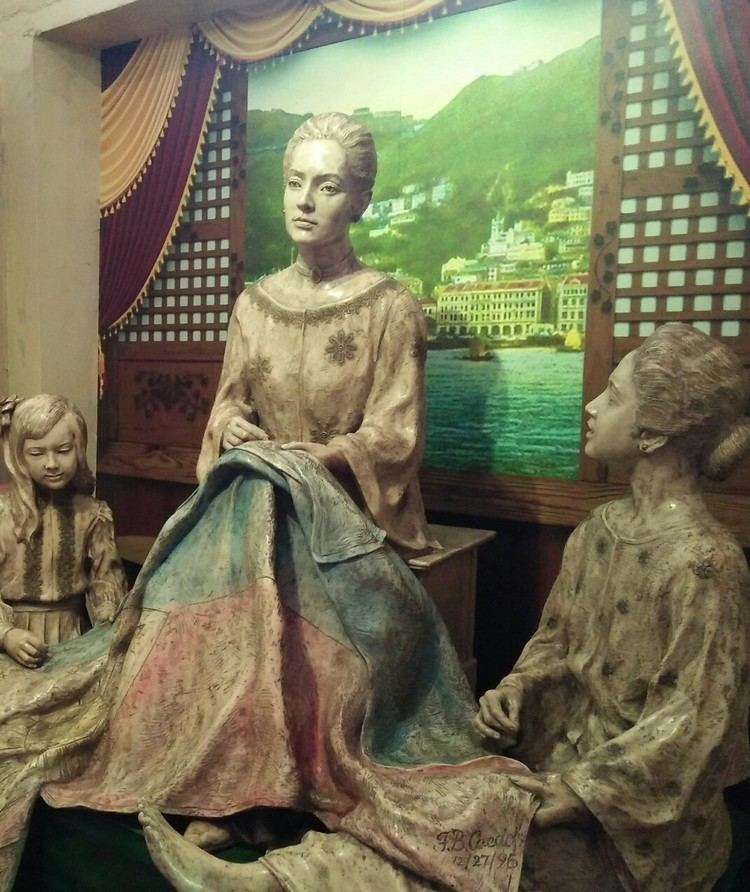Full Name Lorenza Marino Religion Roman Catholic Nationality Filipino Name Lorenza Agoncillo | Other names Enchang Resting place La Loma Cemetery Occupation Patriot and Educator | |
Known for daughter of the principle seamstress of the first and official Philippine flag Education Philippine Normal University Grandparents Ramon Agoncillo, Gregoria Encarnacion, Eugenia Coronel, Francisco Marino Died September 2, 1972 (aged 81) Manila, Philippines Similar Felipe Agoncillo, Marcela Agoncillo, Delfina Herbosa de Natividad | ||

Lorenza Marino Agoncillo (September 5, 1890 - September 2, 1972) was the daughter of Don Felipe Agoncillo and Marcela Agoncillo who became the daughter of the principle seamstress of the first and official Philippine flag.
Contents
Early life
Born on September 5, 1890 in Taal, Batangas, she was the eldest daughter of Felipe Agoncillo, a lawyer who later became a diplomat in the first Philippine Republic, and Marcela Marino, who belonged to one of the distinguished families of Taal.
As a Flagmaker
She was one of the three women who made the first Philippine flag. As the story goes, around March or April 1898, Aguinaldo requested Marcela Agoncillo to make the Philippine flag according to a design, inspired by the Cuban flag, given by the revolutionary committee. Lorenza, then seven years old, helped her mother in sewing the flag together with Rizal’s niece, Delfina Herbosa Natividad. The task was finished in five days. Aguinaldo took the flag with him when he sailed back to the Philippines on the U.S. transport McCulloch after the defeat of the Spanish fleet in Manila Bay. It was waved from the window of Aguinaldo’s house in Kawit, Cavite after he declared the independence of the Philippines on June 12, 1898.
As a Catholic
Lorenza was a devout Catholic. She entered the congregation of St. Paul de Chartres, intending to become a nun. However, a strange disease affecting her kidneys forced her to abandon the vocation. After recovering her health, she studied at the Philippine Normal School. She became a teacher at the Malate Catholic School, serving there for 50 years. Like her sisters, she was a cultured woman. She sang beautifully and recited with ease poems like Rizal’s “Mi Ultimo Adios” at family gatherings. The old Agoncillo house in Malate, which she shared with her sisters, revealed her fine artistic tastes. She was also known for being softhearted. She could not refuse anyone who appealed for financial help, whether deserving or not. Agoncillo lived through the hardships of the Japanese occupation and the horrors of the liberation of Manila, during which the family house was destroyed. Among the buildings that were heavily damaged in the area was the Malate Catholic School, which she sought to reopen. She became the driving force not only in restoring the school but also in managing it so it could resume its role as an educational institution. To this twin effort, she gave complete dedication.
Later life
In 1967, she received a Plaque of Merit for her invaluable contributions to the school. Like her parents, Agoncillo was patriotic and well – bred. Her dignity was an inspiration to both her colleagues and the thousands of students who passed under her care.
Death
She died on September 2, 1972, three days short of her 82nd birthday.
